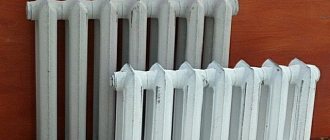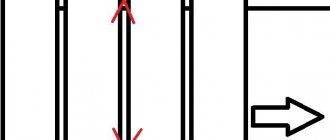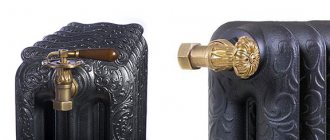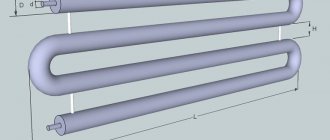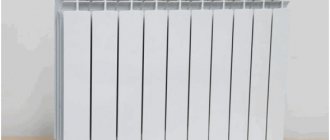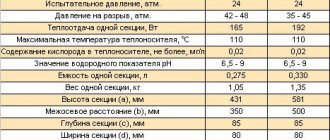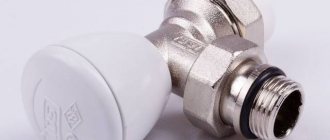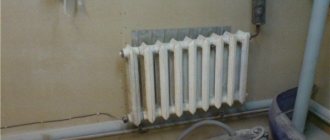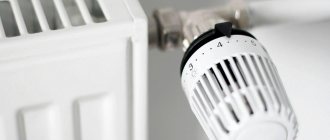Radiator heat transfer: what does this indicator mean?
The term heat transfer means the amount of heat that a heating battery transfers to a room over a certain period of time.
There are several synonyms for this indicator: heat flow; thermal power, device power. The heat output of heating radiators is measured in Watts (W). Sometimes in the technical literature you can find a definition of this indicator in calories per hour, with 1 W = 859.8 cal/h. Heat transfer from radiators occurs through three processes:
- heat transfer;
- convection;
- radiation (radiation).
Each heating device uses all three heat transfer options, but their ratio differs for different models. Previously, it was customary to call radiators devices in which at least 25% of the thermal energy is released as a result of direct radiation, but now the meaning of this term has expanded significantly. Nowadays, convector-type devices are often called this.
Temperature pressure of a heating radiator - what is it?
Home / Communications / Heating / Temperature pressure of a heating radiator - what is it?
Heat transfer from a radiator is an indicator that indicates the amount of heat transferred by a radiator to a room per unit of time. It is measured in Watts (W). You can also find other names for this indicator on the Internet: thermal power, power, heat flow
. Cal/hour can also be found as a unit of measurement of heat transfer; they can be converted to Watts and vice versa according to the dependence: 1 W = 859.8452279 cal/h.
Heat transfer to a room occurs through two processes: radiation and convection. The design of modern heating devices is designed in such a way that, by combining both processes, maximum heat transfer is achieved.
The thermal power of radiators depends, in addition to its design, on three quantities: the temperature of the coolant at the radiator inlet, at the outlet and the air temperature in the room. Temperature difference (Δt, K) represents the difference in temperature between the radiator and the room. The radiator temperature is taken as the average between the temperatures at the inlet and outlet of the radiator. Thus, the simple formula for temperature pressure is as follows:
This formula is widely used both for calculations and in reference literature. But calculating the radiator temperature as an arithmetic mean does not reflect the actual temperature of the radiator. A more accurate value can be obtained using a logarithmic dependence, then the logarithmic formula for temperature pressure will look like this:
In the technical documentation of radiator manufacturers, you can find heat transfer values obtained using three main test methods: according to EN-442, DIN 4704 and NIIST standards. EN 442 is a pan-European standard that all heating device manufacturers follow. Tests are carried out at a temperature of 75/65/20 in the cabin, where the ceiling, floor and walls except those opposite the radiator are cooled. In accordance with the DIN 4704 standard, the heating device is tested at 90/70/20 mode and all enclosing structures are cooled. According to NIIST, the temperature difference is 70 o C, the wall opposite the radiator and the floor are not cooled, the radiator is separated from the wall by a heat-insulating screen. The heat transfer obtained according to different standards may differ by 1-8%.
If the heating system uses a different temperature regime, then the heat transfer of the heating devices must be recalculated. This can be done using the heat transfer conversion formula :
The n indicator characterizes the design of the radiator. The higher this indicator, the more significantly the heat transfer drops at low-temperature heating modes, and, conversely, the faster it increases at high coolant temperatures.
This online program takes into account the influence of the following factors on heat transfer from radiators: atmospheric pressure (affects heat transfer by up to 4%), method of connecting the radiator (affects heat transfer by up to 22%). The program also allows you to recalculate the actual heat transfer of the radiator depending on the temperature pressure and coolant flow; however, for this purpose it is better to use the manufacturer’s technical documentation. The program can be used for cheap and little-known brands of radiators for which there is not enough data.
Thermal power of the radiator, W at Δt= o C
Installing new heating radiators is always associated with the problem of choice, and most homeowners only have approximate information about one or another type of battery. Based on it, it is difficult to make a choice, although many act on the principle of “take what is cheaper.” At the same time, it is easy to make a mistake, which, on the contrary, will lead to an increase in the cost of the project as a whole. In this article we will compare such a parameter as the heat transfer of radiators, which will help you make the right decision.
Thermal power is one of the main characteristics, but there are others that are no less important. Selecting a battery only on the basis of the required heat flow is wrong. You need to understand under what conditions a particular radiator produces the specified flow and how long it will last in your home heating system. Therefore, it is more correct to consider all the main technical characteristics of sectional types of heaters, namely:
- aluminum;
- bimetallic;
- cast iron
Let's compare heating radiators according to the following main parameters, which play an important role in their selection:
- thermal power;
- permissible working pressure;
- crimping pressure (test);
- capacity;
- weight.
Note. We do not take into account the maximum degree of heating of the coolant, since for batteries of all types it is quite high, which makes them suitable for use in residential buildings according to this parameter.
Operating and test pressure indicators are important for selecting batteries for different heating systems. If in cottages or country houses the coolant pressure rarely exceeds 3 Bar, then with centralized heat supply it can reach from 6 to 15 Bar, depending on the number of floors of the building. We should not forget about water hammer, which is not uncommon in central networks when they are put into operation. For these reasons, it is not recommended to include every radiator in such networks, and it is better to compare heat transfer taking into account characteristics that indicate the strength of the product.
The capacity and weight of heating elements play an important role in private housing construction. Knowing the radiator capacity will help calculate the total amount of water in the system and estimate the thermal energy consumption for heating it. The weight of the device is important for determining the method of attachment to an external wall, built, for example, from a porous material (aerated concrete) or using frame technology.
To familiarize yourself with the main technical characteristics, we present in the table the data of the well-known manufacturer of aluminum and bimetal radiators - the company RIFAR, as well as the parameters of cast iron batteries MS-140.
As the table below compares the heat transfer of heating radiators shows, the most efficient in terms of power are bimetallic heaters. Let us remind you that they are an aluminum finned body with a strong welded frame inside made of metal tubes for the flow of coolant. In all respects, this type of heater is suitable for installation both in heating networks of high-rise buildings and in private cottages. Their only drawback is their high cost.
The heat transfer of aluminum radiators is slightly lower, although they are lighter and cheaper than bimetallic ones. In terms of test and operating pressure, aluminum devices can also be installed in buildings of any number of floors, but subject to: the presence of an individual boiler room with a water treatment unit. The fact is that aluminum alloy is susceptible to electrochemical corrosion from low-quality coolant inherent in central networks. It is better to install aluminum radiators in separate systems.
The procedure for calculating the heat transfer of a heating radiator
The choice of heating devices for installation in a house or apartment is based on the most accurate calculation of the heat transfer of heating radiators. On the one hand, every consumer wants to save money on heating their home and therefore has no desire to purchase extra batteries, but if there are not enough of them, it will not be possible to achieve a comfortable temperature. There are several ways to calculate the heat transfer of a radiator.
Option one
. This is the simplest way to calculate heating radiators; it is based on the number of external walls and windows in them.
The calculation procedure is as follows:
- when the room has only one wall and a window, then for every 10 “squares” of area, 1 kW of thermal power of heating devices is required (for more details: “How to calculate the power of a heating radiator - we calculate the power correctly”);
- if there are 2 external walls, then the minimum battery power should be 1.3 kW per 10 m².
Option two
. It is more complex, but allows you to have more accurate data on the required power of devices.
In this case, the calculation of heat transfer from the heating radiator (batteries) is carried out using the formula:
S xh x41, where S is the area of the room for which calculations are performed; H - room height; 41 – minimum power per cubic meter of room volume.
The resulting result will be the required heat transfer for heating radiators. This figure is then divided by the rated thermal power that one section of a given battery model has. You can find out this figure in the instructions supplied by the manufacturer with your product. The result of calculating heating radiators will be the required number of sections so that the heat supply to a particular room is effective. If the resulting number is a fraction, then it is rounded up. A little excess heat is better than too little heat.
Calculation of thermal power of radiators
As has already been mentioned several times, the heat transferred by radiators to the air in the room must compensate for the heat loss of the room and, in a simplified form, this corresponds to the fact that for every 10 m² of room area, radiators with a thermal power of at least 1 kW must be installed. In practice, this figure is increased by another 15%, i.e. the resulting radiator power is multiplied by a factor of 1.15. There are more accurate calculations of the required power of radiators, which are used by experts, but for a rough estimate the proposed method is sufficient. With this calculation method, radiators may turn out to be a little more powerful than necessary, but the quality of the heating system will increase, which allows for more precise settings and low-temperature heating modes.
When purchasing radiators in stores, in the technical specifications data sheets, the thermal power can be indicated in kilowatts or by coolant flow. If the coolant flow rate is indicated, then we already know that a coolant flow rate of 1 l/min approximately corresponds to a power of 1 kW.
Typically, the radiator dimensions in millimeters are indicated in the heating device passport. Currently, radiators on sale come in heights of 60, 50, 40, 30 and 20 cm; devices with a height of 20 cm or less are called baseboard. The height of 60 cm is the traditional height of old cast iron radiators, and the new radiators with a height of 60 cm are good for easy replacement. Nowadays, radiators with a height of 50 cm are more often used, since high windows and low window sills are increasingly used in architecture, and when installing a radiator under a window, you need to maintain a standard gap between the window sill board and the radiator of at least 5 cm, and the distance between the floor and the radiator should not be less than 6 cm. Low radiators look more compact, but with the same power they will be longer, and the size of the room does not always allow the installation of longer radiators.
In the radiator passport, next to the power, for example, 1905 W, the figures for the calculated temperature difference are indicated, for example, 70/55. This means that when cooled from 70 to 55 degrees, the radiator emits 1905 W of thermal power from its surface. However, many sellers indicate the power of their radiators only for a 90/70 difference. When using such radiators for medium-temperature heating systems with a difference of 70/55, the heat transfer power of such a radiator will be less than that stated in the passport. Therefore, when choosing radiators for medium and low temperature (55/45) heating systems, their actual power must be recalculated.
The power of the heating device is determined by the formula:
Q = k×A×ΔT, where k is the heat transfer coefficient of the heating device, W/m² °C; A is the area of the heat transfer surface of the heating device, m²; ΔT—temperature difference, °C (Fig. 82).
From the radiator datasheet we know the radiator power (Q) and the temperature difference (ΔT) corresponding to this power. Substituting these values into the formula, we determine the product k×A. Now all the components of the formula are known, substituting the ΔT value equal to 50 or 30 ° C, corresponding to medium and low temperature heating systems, we find the power of a given radiator for these systems. Moreover, the power of radiators can be recalculated to their temperature difference (ΔT), if for some reason you are not satisfied with the standard values of 50 and 30 ° C, using the formula in Figure 82.
For example, we need to choose radiators for a room of 16 m². To heat such an area, radiators with a power of 1.6 kW are needed, multiply this number by a factor of 1.15 and get 1.84 kW. We come to the store and choose a radiator that is suitable for us in size and power. Let’s assume that we find a heating device whose rating data indicates a power of 1905 W (1.9 kW). Studying the passport data, we find that this radiator can produce the specified power only at a temperature pressure of 60°C (90/70). However, we know in advance that our heating system will be made with high-quality temperature control of the coolant - using three-way mixers and will operate in low temperature mode (55/45) with a temperature difference ΔT = 30°C. Therefore, it is necessary to recalculate the power of the proposed radiator. Using the formula or passport data, we find the value of the product k×A = 31.75 W/°C and insert the updated data into the power determination formula. Q = k×A×ΔT = 31.75×30 = 956 W, which is approximately 50% of the power we need. Then you can proceed in several ways: buy two radiators instead of one; calculate the power of one radiator section and, based on this calculation, select a radiator with the required number of sections; look for other radiators that meet our requirements. It should be added that when purchasing radiators for low-temperature heating systems (ΔT = 30°C), the passport data of which indicates a temperature difference of 60°C, the result will always be the same - the number of radiator sections must be doubled. In other cases, when the passport indicates other temperature pressures or you have your own requirements for the calculated temperature pressure, the power of the radiators needs to be recalculated. As you have seen, this is not difficult at all.
The heat transfer from radiators to the room is also influenced by the location of the radiator in the room and the way it is connected to the pipelines.
Radiators are placed primarily under light openings. No matter what state-of-the-art double-glazed windows are installed in window frames, the window is always the place of greatest heat loss. A radiator placed under the window heats the air around it. Rising upward, hot air creates a thermal curtain in front of the window, preventing the spread of cold from the window. In addition, the cold air from the window immediately mixes with the warm air rising from the radiator and enhances convection throughout the room, helping to warm up the entire air in the room more quickly. It is desirable that the radiator “accordion” be the length of the entire width of the window, in extreme cases, at least 50% of the length of the openings. The vertical axes of the window opening and the radiator are aligned, the permissible deviation is no more than 50 mm. In corner rooms, additional radiators can be placed along blank external walls, as close to the outer corner as possible. When using riser heating systems, risers must be placed in the corners of the room; it is especially important to place risers in the outer corners of corner rooms. The point here is that the outer corners of houses are attacked by cold air, unlike walls, from two sides. By placing heating risers in the corners, you ensure their heating from the inside and sharply reduce the likelihood of dampness and blackening of the wall material - the development of fungal growths in the corners.
Heating appliances are placed so that they can be inspected, cleaned and repaired. If fencing (screen) or decoration of devices is used, then adjustments must be made to the calculation of the thermal power of the radiators. The power of purchased radiators must be calculated with a correction factor (Fig. 83).
Fig.83. Changing the heat transfer power of radiators depending on the method of their installation
The connection of pipes to radiators can be on one side (unilateral) or on opposite sides (multilateral). When connecting pipes from different sides, the heat transfer of the devices increases, however, it is structurally more rational to make one-sided connection of pipes. Radiators are connected from different sides when the number of sections is more than 20, as well as when the number of devices “on the hitch” is more than one.
The heat flow of radiators depends on the location of the coolant supply and removal points. Heat transfer increases when the coolant is supplied to the upper part and removed from the lower part of the device (direction of movement from top to bottom) and decreases when the direction of movement is from bottom to top (Fig. 84). When installing heating devices in several tiers in height (by floor), it is recommended to ensure consistent movement of the coolant from top to bottom.
Fig.84. Changing the heat transfer power of radiators depending on the method of connecting pipes to them
Individual regulation of heat transfer of heating devices can be manual or automatic. Thermostatic valves regulate the flow of coolant in such a way that they achieve the best heat transfer rates in all areas of the heating device.
Source: “House heating. Calculation and installation of systems » 2011. Savelyev A.A.
Heat dissipation of batteries made of different materials
When choosing a heating radiator, you should remember that they differ in the level of heat transfer.
The purchase of batteries for a house or apartment should be preceded by a careful study of the characteristics of each model. Often devices that are similar in shape and size have different heat output. Cast iron radiators
. These products have a small heat transfer surface and are characterized by insignificant thermal conductivity of the manufacturing material. The rated power of a section of a cast iron radiator, such as MS-140, at a coolant temperature of 90°C is approximately 180 W, but these figures were obtained in laboratory conditions (for more details: “What is the thermal power of cast iron heating radiators”). Heat transfer is mainly carried out due to radiation, and convection accounts for only 20%.
In centralized heating systems, the coolant temperature usually does not exceed 80 degrees, and in addition, part of the heat is consumed when hot water moves to the battery. As a result, the temperature on the surface of the cast iron radiator is about 60°C, and the heat transfer of each section is no more than 50-60 W.
Steel radiators
. They combine the positive characteristics of sectional and convection devices. They consist, as can be seen in the photo, of one or several panels in which the coolant moves inside. To increase the heat transfer of steel panel radiators, special fins are welded to the panels to increase power, functioning as a convector.
Unfortunately, the heat transfer of steel radiators is not very different from the heat transfer of cast iron radiators. Therefore, their advantage lies only in relatively light weight and more attractive appearance.
Consumers should be aware that the heat transfer of steel heating radiators is significantly reduced if the coolant temperature decreases.
For this reason, if water heated to 60-70°C circulates in the heating system, the indicators of this parameter may differ greatly from the data provided for this model by the manufacturer. Aluminum radiators
. Their heat transfer is much higher than that of steel and cast iron products. One section has a thermal power of up to 200 W, but these batteries have a feature that limits their use. It serves as a coolant. The fact is that when contaminated water is used from the inside, the surface of the aluminum radiator is subject to corrosive processes. Therefore, even with excellent power indicators, batteries made of this material should be installed in private households where an individual heating system is used.
Bimetallic radiators
. These products are in no way inferior to aluminum devices in terms of heat transfer. The heat flow of bimetallic products is on average 200 W, but they are not so demanding on the quality of the coolant. True, their high price does not allow many consumers to install these devices.
Dependence of the degree of heat transfer on the connection method
The heat transfer of heating radiators is affected not only by the material of manufacture and the temperature of the coolant circulating through the pipes, but also by the chosen option for connecting the device to the system:
- The connection is direct one way
. It is the most favorable in relation to the thermal power indicator. For this reason, the calculation of the heat transfer of a heating radiator is performed precisely with a direct connection. - Diagonal connection
. It is used if you plan to connect a radiator to the system in which the number of sections exceeds 12. This method allows you to minimize heat loss. - Bottom connection
. It is used when the battery is connected to a floor screed in which the heating system is hidden. As the calculation of the heat transfer of the radiator shows, with such a connection, the loss of thermal energy does not exceed 10%. - Single pipe connection
. The least profitable method in terms of thermal power. Heat transfer losses with a single-pipe connection most often reach 25 - 45%.
What needs to be taken into account when calculating?
Calculation of heating radiators
Be sure to take into account:
- The material from which the heating battery is made.
- Its dimensions.
- The number of windows and doors in the room.
- The material from which the house is built.
- The direction of the world in which the apartment or room is located.
- Availability of thermal insulation of the building.
- Type of pipe system layout.
And this is only a small part of what needs to be taken into account when calculating the power of a heating radiator. Don’t forget about the regional location of the house, as well as the average street temperature.
There are two ways to calculate the heat transfer of a radiator:
- Regular - using paper, pen and calculator. The calculation formula is known, and it uses the main indicators - the thermal output of one section and the area of the heated room. Coefficients are also added - decreasing and increasing, which depend on the previously described criteria.
- Using an online calculator. It is an easy-to-use computer program into which certain data about the size and design of the house is loaded. It gives a fairly accurate indicator, which is taken as the basis for designing a heating system.
For the common man, both options are not the easiest way to determine the heat transfer of a heating battery. But there is another method for which a simple formula is used - 1 kW per 10 m² of area. That is, to heat a room of 10 square meters, you will need only 1 kilowatt of thermal energy. Knowing the heat transfer rate of one section of a heating radiator, you can accurately calculate how many sections need to be installed in a particular room.
Let's look at a few examples of how to correctly carry out this calculation. Different types of radiators have a large size range, depending on the center distance. This is the size between the axes of the lower and upper manifold. For the bulk of heating batteries, this figure is either 350 mm or 500 mm. There are other parameters, but these are more common than others.
This is the first one. Secondly, there are several types of heating devices made of various metals on the market. Each metal has its own heat transfer, and this will have to be taken into account when calculating. By the way, everyone decides for themselves which radiator to choose and install in their home.
Ways to increase heat transfer
Regardless of the power of radiators, owners of houses and apartments still want to increase their heat output. This desire becomes especially relevant with the advent of the cold season. In the winter cold, often even when operating at full power, the radiator may not be able to maintain a comfortable temperature in the room.
There are several ways to increase the heat transfer of heating devices:
- Regular wet cleaning to clean the surface of the batteries. The cleaner they are, the higher their level of heat transfer.
- Equally important is the correct painting of the radiator, especially for cast iron appliances. The fact is that multi-layer applied paint prevents effective heat transfer. Before you start painting the heating radiator, you should remove the old layer. No less effective is the use of special enamels intended for pipelines and heating devices, since they have low resistance to heat transfer.
- To ensure maximum power, these devices must be installed correctly.
- Among the main mistakes made during installation, experts note:
- tilting the battery; - installing the device too close to the floor covering or to the wall; - blocking access to radiators with furnishings and installing inappropriate reflective screens. - To increase the efficiency of heating batteries, it would not hurt to inspect their internal cavity. Often, in the process of connecting heating radiators to the system, burrs are formed, due to which, during operation, blockages are formed that prevent the free movement of the coolant.
- You can place a heat-reflecting screen made of foil material on the wall behind the heating device.
Educational video about heat transfer from heating radiators:
It is not difficult to calculate the heat transfer of a radiator, which is necessary for a specific room, as becomes clear from the above information. Knowing its value, you can choose the desired model, and then personally increase the power of the device and thereby provide yourself and your loved ones with comfortable living conditions in the winter. About
